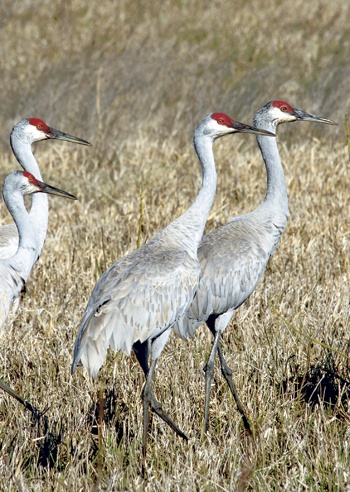I recently developed an interest in birds despite my poor vision and resistance to getting up early. I can watch common birds drinking from the fountain in my backyard, but after reading The Echo Maker (Thompson Gale, 2006), a novel by Richard Powers, I felt a yearning to see something epic, specifically Sandhill Cranes.
I had been carried along by the author’s eloquence as he described a migratory stop: “They converge on the river at winter’s end as they have for eons, carpeting the wetlands … the oldest flying things on earth, one stutter-step away from pterodactyls. As darkness falls for real, it’s a beginner’s world again, the same evening as the day sixty million years ago when the migration began.”
So Powers describes the birds’ arrival in spring and fall on the Platte River in Nebraska, where they stop to clean up harvested grainfields. They do the same in far North Texas on their yearly circuit from summer nesting grounds in the northern U.S., Canada and the Arctic to winter feeding areas in Northern Mexico, New Mexico and Texas.
I wanted to be in the presence of this magic. Even if I can’t write with Powers’ eloquence, I wanted to see and report on these magnificent creatures, so large they are employed by rescue workers to foster chicks of endangered whooping cranes. The Texas sanctuary that usually records the most Sandhill Cranes is the remote Muleshoe National Wildlife Refuge on the High Plains, the oldest national wildlife refuge in the state. In February 1981, the count reached a soaring high of 250,000. The fact that the birds are usually at their most bountiful when it’s as cold as it gets in Texas—they begin arriving in about October and leave in early March—did not deter me.
I’d been hounding the wildlife refuge manager by telephone asking for a crane count every week. Right before my trip in early 2011, there were about 8,000 cranes at the refuge and 16,000 or so in the area. No records were going to be broken, but after you’ve seen several thousand, who’s counting?
Those of you who don’t get around much might not know of Muleshoe, home of Bailey County Electric Cooperative. To get there, find your way to Lubbock and proceed about 70 miles northwest; from Amarillo, go about 100 miles southwest. You’ve gone too far if you reach the New Mexico line. The cranes are attracted by grain in nearby wheat fields and insects, rodents and tubers. They feed and socialize during the day and seek overnight accommodations where they can keep their feet wet and watch out for predators.
My friends Saralee, Sara and I drove from Austin, leaving about 7 a.m. and arriving at the wildlife refuge, which is 20 miles south of Muleshoe on State Highway 214, at about 5 p.m. It was pretty clear that the cranes were going to be at Paul’s Lake because it was the only one of the three extant playa lakes within the 5,000-acre refuge that had water.
Because of the drought, one had to look sharp to see any water at all. Playas are formed in depressions where freshwater precipitation or spring water accumulates and then evaporates. Paul’s Lake is a desolate clay expanse, lumpy with encrusted minerals, predominantly salt. Scrawny, salt-tolerant vegetation rings the playa. Other than that, it’s sky as far as you can see.
I couldn’t see any cranes at all until Saralee, a genuine birdwatcher, pointed across the playa to what looked to me like piles of gray stones at the edge of the water. When I adjusted my binoculars, and the prairie wind died down, I could see them and hear their rough cries. They were standing close together in shallow water. And more were arriving every minute. From a distance, they looked like V-shaped wisps of smoke, circling downward, getting darker and denser as each new group circled the playa and landed on the other side of the lake. They seemed to shy away from our side of the lake with its observation platform, and they were too far away to judge their height or fully admire their wingspans, which spread up to 6 feet across.
It was on to Muleshoe for the night, but the next morning found us up well before dawn in our warmest clothes. It was literally a beginner’s world for me. I rarely get up before dawn and had never done so on the High Plains, hushed under a vast obsidian dome of stars.
Even before the sun rose, we sensed stirrings across the lake and could hear soft vocalizations. It seemed as if the cranes would all be gone by the time the sun came up. But just as the morning sky turned pink, four cranes flew silently over us; graceful necks stretched urgently forward, spindly legs elongating each torso to at least my 5-foot height. Powerful black-tipped wings cut the freezing air with the merest effort.
As Powers writes, “The blood-red head bows and the wings sweep together, a cloaked priest giving benediction.”
As they journeyed toward the sunrise, all I could do was give thanks for being present for a few seconds of their never-ending cycle.
——————–
Kaye Northcott is retired editor of Texas Co-op Power.
Author’s note: To hear the cranes’ cries, go to www.savingcranes.org/sandhill crane.html.


